
Jason Taylor’s 1964 Jeep CJ-5 boasts a unique engine swap: the Nash-Rambler OHV 196 inline six-cylinder, iron block engine…Note the great fit. For Jeep enthusiasts and motorheads, this vintage swap deserves our attention!
(Photos provided by Jason Taylor)
Jason Taylor sent an Email note to the “Q&A” column at the magazine, asking a practical question: “I have a 1964 Jeep CJ-5 that a previous owner modified. The Jeep has a T98 transmission coupled to an AMC 196. The engine bay and firewall were modified to accept the longer engine. I would like to replace the 196 with an engine that has more parts availability and carburetor options for inclines and off-camber situations. Would other AMC inline sixes be a bolt-in replacement, or do I need to go another direction?”
The note caught Moses Ludel’s attention. Moses took his first driving exam in a near-new 1964 Jeep CJ-5 that had the rare, optional T98 four-speed transmission—and an F-head four-cylinder engine. The F-134 had distinct shortcomings.
By the mid-1960s, Jeep CJ-5 engine swaps were common. Interstates and high speed highways made engines like the 6.9:1 compression, 72-horsepower 134 four-banger an on-pavement liability. Moses Ludel recalls Nevada’s “basic speed law” of the period, essentially, drive as fast as you want without causing an accident. The F-head four simply could not compete with the high compression muscle cars of the era!
In 1966, Kaiser remedied the CJ power dilemma with the introduction of a 225 V-6 engine (Buick sourced) option. From that point forward, the Jeep CJ, and subsequent Wrangler models, were multipurpose contenders in the 4WD market. By 1972, with the AMC acquisition of Jeep in 1970, the AMC inline sixes and V-8 engines became a mainstay.
For a 1964 CJ-5 “in the day”, an engine swap was either the Buick 225 V-6, the aluminum G.M. 215 V-8, or popular small-block Chevrolet and Ford V-8s. Many 1941-71 Jeep models boast these kinds of swaps. Kaiser’s choice of the 225 for CJs and Jeepsters came with a switch to a Buick 350 V-8 option in the J-truck and Wagoneer. From 1965-68, these J-models and the Wagoneer offered a 327 AMC V-8 option (not to be mistaken for a Chevrolet 327 V-8, although they share bore/stroke dimensions).
Kaiser also added the AMC inline sixes in 1965. The full-size Wagoneer and J-truck models had limped along with the 230 Tornado overhead camshaft inline six from 1962-64. (Even the last Willys Wagon saw use of this engine.) This Kaiser innovation modified the four-main bearing L-head inline six, boosting displacement from 226 to 230 while adding a “groundbreaking” OHC cylinder head. Many years ahead by design, the OHC was also problematic; it did not deliver the power or reliability that Jeep truck owners expected.
Kaiser’s Jeep Corporation turned to the new AMC 232 seven-main bearing engine as a solution. This inline six delivered, so well that its basic design served Jeep models through the 2006 TJ Wrangler! Yes, this was the “bulletproof” inline six that took form as the original 199/232, advancing to the 258/4.2L and 4.0L inline Jeep sixes.
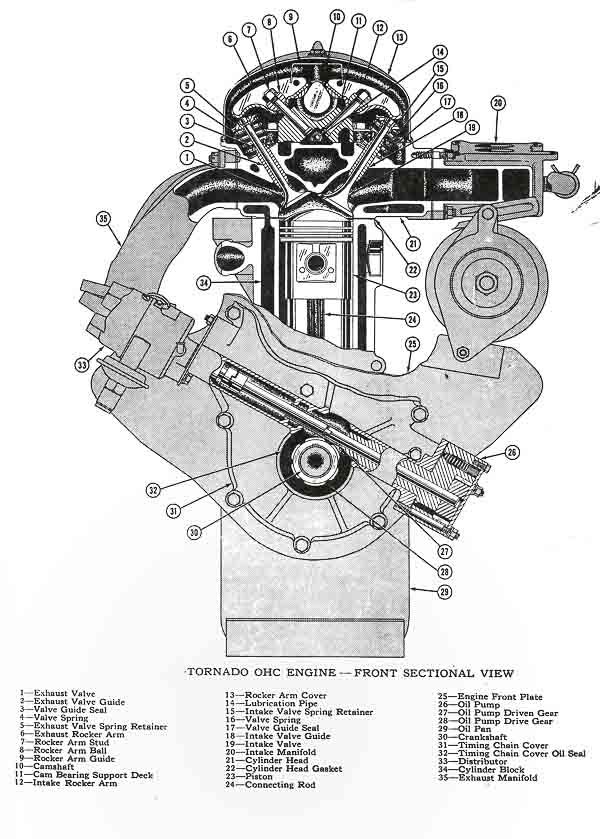
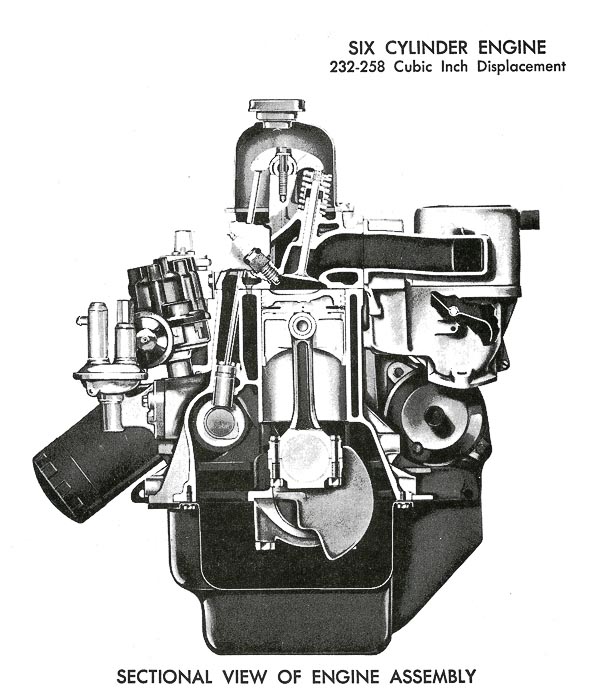
At left is the OHC (overhead camshaft) inline 230 Tornado Six that replaced the Kaiser 226 L-head. The Tornado is found in some late Willys Wagons, the 1963-64 Jeep Gladiator trucks and the 1962-64 Wagoneer. At right is the AMC 232 that replaced Kaiser’s OHC 230 in the 1965 Jeep J-trucks and the Wagoneer. The OHC 230 survived in military M-715 Gladiator-looking trucks through 1969.

Late 4.0L inline Jeep six reflects the 1964-up AMC 199/232/258 design. This MPI engine fits a contemporary Mopar concept vehicle, the “Willys Wagon”, originally equipped with a Kaiser 226 inline six. The Willys chassis, same era as Jason’s CJ-5, has an engine bay designed for a longer inline six-cylinder engine. Jeep CJ models did not have this length engine bay until the 1972-up AMC/Jeep era.
When Jason Taylor’s 1964 underwent its engine swap, the engine choice might have seemed unusual to some. With closer consideration, the 199 or 232 Jeep inline sixes, introduced by AMC in 1964-65, would have been too long for a 1955-71 CJ-5 chassis and engine bay. When AMC installed the 232 and 258 in the CJs (1972), the frame and engine bay were stretched by three inches to accommodate the seven-main bearing blocks.
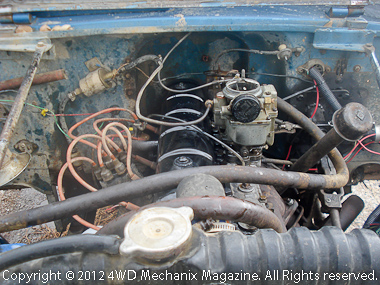
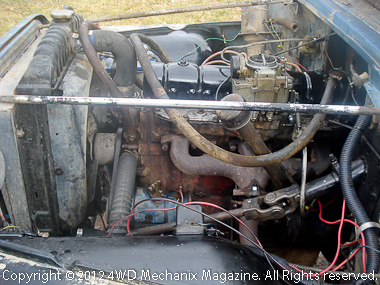
Jason Taylor’s 1964 Jeep CJ-5 boasts the original AMC stroker motor swap! Note the ease and simplicity of this conversion. Ducting sheet metal at stock radiator core support has been sectioned. A homemade spacer box takes its place. The 3.125″ bores of the 196 make the overall length of this engine relatively short—the rare inline six that can squeeze into an F-134 chassis and engine bay!
Apparently, the CJ-5’s earlier owner shied away from the V-8 swap popularity. A Ford 221, 260 or 289 small-block V-8 made an optimal fit, even in an MB or flat fender model! Even a Chevy 265, 283 or 327 V-8 could be done. These engines helped a CJ-5 keep up with the V-8 model Scout, Bronco, Suburban, Blazer/Jimmy and other SUVs.
So why an AMC 196? And what’s an AMC 196, anyway? For starters, not all Jeep owners were high performance enthusiasts. Some simply wanted more torque and a bit more horsepower than the 134-four had to offer. For this owner, an AMC 196 made sense. A closer look at the 196 reveals a variety of reasons for this conversion.

The Nash/AMC 196 six dates from the L-head era and first appeared as a 1952 Nash ‘Statesman’ offering. This is a rugged, long-stroke (4.25″), smaller bore (3.125″) design, a true “stroker motor”! The engine was an AMC mainstay for years and came in two forms: OHV (at left) and L-head (right).
An AMC 196 six was not like the AMC 199 or 232/258 and 4.0L AMC seven-main bearing sixes popularized in Jeep vehicles. The vintage 196 design came in three forms: L-head (“side valve”) and two Rambler OHV versions, one an iron block (through 1965), the other an ill-fated aluminum block version built from 1962-64.
Fortunately, Jason’s 1964 CJ-5 Jeep has the two-barrel carbureted, OHV engine (at left in photo above) with an iron block and 8.7:1 compression, rated 138 horsepower @ 4,500 rpm and 185 lbs. ft. torque @ 1800 rpm. This is useful power for a lightweight, pre-AMC vintage CJ 4WD—actually, this is stump-pulling power!
The 196 was an early design block from the Nash period that came in L-head and overhead valve versions by the end of its era. The bellhousing pattern and all other features of this four-main bearing engine differ from the 1964-up 199/232/258 and derivative 242/4.0L seven-main bearing AMC sixes. A later AMC inline six would not be a sensible swap for a Kaiser era CJ-5.
By design, an iron block AMC 196 is a somewhat rugged engine that requires only routine maintenance. By contrast, the Rambler aluminum block version needs constant cylinder head re-torquing. The aluminum 196 was not only susceptible to blowing head gaskets, quite often this led to burning a channel between two cylinders at the top of the block deck!
Jason’s iron block 196 has four main bearings. (Vintage Jeep inline sixes through the Tornado 230 OHC design were also four main bearings.) The engine’s carburetor I.D. tag indicates a 1964 production date, the same year that AMC introduced the 199/232 design. Overhead valves gave the 196 a 138 horsepower rating in the late (1962-64) two-barrel carbureted form, with a frisky, modern 8.7:1 compression! This classic stroker motor (long stroke and smaller bore or “under-square”) yielded a quick torque rise with 185 ft-lb torque at an impressively low 1,800 rpm. This kind of torque rise is optimal for off-road use.
As for alternatives to the 196 vintage iron, Jason could substitute a 4.3L G.M. Vortec V-6 (carbureted or EFI). Howell makes an EFI wire harness for a 4.3L swap, and Advance Adapters can mate the G.M. engine to the rugged T98 Borg-Warner transmission. A 3.8L Buick V-6 engine, carbureted or EFI version, is another prospect. This would be like the ’55 CJ-5 featured in Moses Ludel’s Jeep CJ Rebuilder’s Manual: 1946-71 (Bentley Publishers). Constructing a wiring harness for Buick 3.8L EFI could be more challenging.
Note: Some other contemporary engine swaps would be the Isuzu 3.9L 4BD diesel (can be coupled to a 700R-4 automatic) with wiring…Even a Volkswagen TDI engine would be a consideration, requiring a wire harness and computer. A vintage long shot is the 195 Pontiac slant four (half of a 389 Pontiac V-8), which leans away from the Jeep steering gear. I-H did the same with its 196 four, half of a 392 V-8. A T98 mate-up is not difficult for the Pontiac or I-H fours, Advance Adapters can assist here. A high-tech option would be the contemporary G.M. 5-cylinder inline engine with electronics, ECM and computer/wiring.
Mate-Up of the 196 AMC Six to a T98 Transmission
The 196 inline six in Jason Taylor’s Jeep mates to the Jeep version of the rugged T98 truck four-speed with compound low gear. Kaiser mated 134-fours by using a stock T86/T90 bellhousing and an adapter plate to the T98. Jason found that a Kaiser-Jeep adapter plate had been used with the AMC 196 bellhousing.
American Motors used the T90 on “heavy duty” three speed six-cylinder engine applications from 1959-67. The other transmission application is a T86. One clutch housing for ’64-’65 is listed as a #3171965. Aluminum is typical for later AMC and other bellhousings, particularly the ’62-’65 196 applications. Between Jeep CJ and American Motors components, this became a virtual bolt-in swap, using mostly OEM parts plus a fabricated front engine mount saddle…Someone did his homework!
Note: This Jeep has a later steering column and forwardly mounted steering gear, typical of a Saginaw steering gear swap. This may have been necessary for engine clearance, although doubtful, as the 196 does not have much bulk. The forward steering gear and updated steering column are more likely to improve steering and handling on the Jeep plus eliminate the Ross cam-and-lever steering gear.

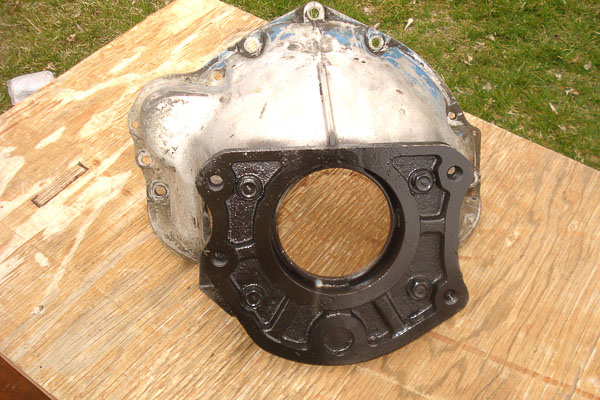
At left is the 196 AMC inline six in Jason’s 1964 CJ-5 Jeep when he bought it. The number of these engines still available is likely small. Our aim is not to start a rush on 196 AMC six swaps into vintage CJs! We simply want to illustrate parts interchangeability and owner/builder ingenuity over time. AMC used Borg-Warner transmissions like the T86 and also the T90 (similar to Jeep applications and mounting patterns)…At right is an F-134/T98 adapter plate fitted to the stock 196 bellhousing—just as this plate fits to the stock F-head bellhousing and a T98 four-speed! The correct length input shaft, clutch disk, release bearing, release fork and crank pilot would round out the package! (Photos courtesy of Jason Taylor.)
Caution: The pilot bearing or bushing is essential to clutch disk alignment. Advance Adapters can furnish pilot bushings by size. (NAPA often can as well.) Make sure the nose of the T98 input reaches into the crankshaft pilot properly. Advance Adapters has stick-out pilots that accommodate shorter input shaft lengths when there is an issue here. Measure the “stack height” and depth of the input shaft…The clutch disk hub must engage the input splines yet not interfere with the pilot bushing. The pilot must support the nose of the input gear.
Note: If the original T98 used a bushing, stay with a bushing. Input gear case hardening determines the type of pilot: either needle bearing or Oilite bushing.
Overall, the AMC 196 made a sensible swap. Minimal engine bay modifications and relatively easy radiator fit allowed use of the mechanical (engine-driven) fan. With the higher CJ-5 hood, there is no issue with the OHV head and stock air filter. Jason’s CJ-5 engine bay actually looks stock. A fabricated front engine saddle mount fits to the stock Jeep 134 frame mounting points—looking as practical as Kaiser’s Buick 225 Dauntless V-6 fit-up. Kaiser’s Dauntless V-6, especially in the earlier installations, looks more like a “factory swap” than an assembly line fit.
The history of Jason Taylor’s CJ-5 engine swap is not clear. Reverse engineering has us praising the engine choice: a high-torque, long stroke engine that uses mostly stock parts to accomplish the T98 truck transmission mate-up. The T90 and T98 were Jeep and Scout offerings; either version mates to a Model 18 transfer case.
This swap could have been motivated by an in-depth knowledge of parts interchangeability—or simply because an AMC 196 engine happened to be available. Either way, the conversion seems practical. The 196, with its small bore size and close bore centers, is shorter in overall length than a seven-main bearing six with larger bores and a shorter stroke.
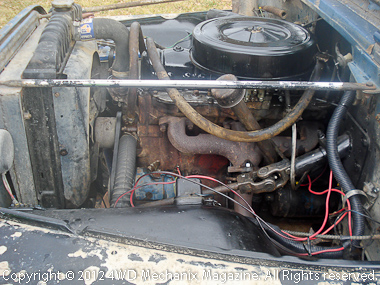
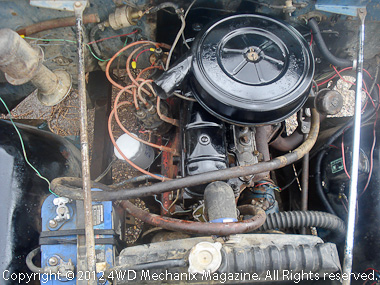
Here, Jason has detailed the 196 engine somewhat as the restoration unfolds. His original idea was to scrap this engine in favor of a modern V-6 swap. Now he has rebuilt the original two-barrel carburetor and wants to give this vintage Nash/AMC engine an opportunity to prove itself!
Jason plans to test the Jeep thoroughly off-pavement. Given the engine’s specs, this should be a stump-pulling crawler with great low-end punch—a stock “stroker motor from the day”! Given the light weight of a Kaiser era Jeep CJ-5, this iron engine should readily permit a curb weight below 2,800 pounds. At a 20-pounds-per-horsepower power-to-weight ratio, Jason Taylor’s Jeep 4×4 should be a gem off-pavement—and perhaps respectable on-pavement as well.
Note: The factory Jeep Dauntless 225 V-6 produced 160 horsepower; however, its slower torque rise netted 235 ft-lbs at 2,400 rpm. The AMC 196 and Buick 225 have similar torque output at 1,800 rpm—and this is a practical, rock crawling engine speed. Geared properly, Jason’s Jeep should get good highway fuel efficiency—after all, these AMC Rambler engines were constant winners in the Mobil Economy Run of their era!
So, engine swaps are nothing new, even for Jeep 4WD utility vehicles! A smaller displacement, under-square, four-main bearing inline six is durable and easy on fuel. For a lightweight CJ Jeep 4×4, the 196 six at 138 horsepower peak would make a substantial performance improvement. For Jason’s Kaiser-era, 81” wheelbase CJ-5, the compact 196 OHV inline six sounds practical. Did Kaiser consider this option before the Buick V-6 choice?
It’s surprising that this swap was not performed often…Prior to the Buick V-6 and aluminum 215 V-8 era, the AMC 196 was around. Buick’s predecessor to the 225 iron V-6 was a smaller 198 cubic inch version (over-square bore/stroke), close to the Rambler 196’s displacement. For torque, you simply cannot beat an under-square 3.125” bore/4.25” stroke engine like the AMC 196. The Buick 198 peaked torque at 2,400 rpm (205 ft-lbs). The AMC climbed quickly to a peak of 185 ft-lbs by 1,800 rpm, performing more like a diesel!
The ’60s Buick V-6 198 and 225 engines are also notorious for odd-firing vibration (caused by paired rods at the crankshaft’s rod pins). An inline six is smoother—”inherently balanced” at critical harmonic levels! While some would question the four-main bearing layout of the 196, the bearing journals on the crankshaft are substantial (similar in size to the AMC seven-main bearing sixes). Engines like the classic Toyota Landcruiser’s F, 2F and 3F-E inline sixes, much like vintage Chevrolet and GMC (“Jimmy”) inline sixes prior to the seven-main era, also have four main bearings.
Perhaps AMC had worn out the 196 tooling by 1964, replacing it with machines and material for the now-legendary 199/232 inline sixes and their successor 258/4.2L and 242/4.0L derivatives. Clearly, these seven-main bearing AMC inline sixes established the Jeep CJ, XJ Cherokee and YJ/TJ Wranglers as the benchmark for reliable 4WD performance!
As for Kaiser’s 1962-71 CJs and the 1967-71 Jeepsters, these 4WDs might have done okay with an earlier AMC inline six: the two-barrel carbureted, 8.7:1 compression version of Rambler’s OHV 196 iron block engine.
Author’s Footnote: Forty-plus years ago, I ‘wheeled alongside a flat-fender CJ-2A, powered by an L-head Studebaker inline six. That swap also worked, a smaller engine without girth or excessive length. As expected, the installer fought the radiator and fan issue, yet it all worked out. Studebaker used B-W transmissions similar to Jeep types, and this allowed the mate-up to a T90 transmission…Another popular swap in the postwar period was the Ford flathead V-8 into a Jeep MB or flat-fender chassis, spurred by the light weight of the flathead and Ford’s use of Borg-Warner transmissions.—Moses Ludel
